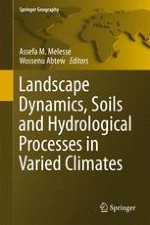2016 | OriginalPaper | Buchkapitel
26. Spatial Runoff Estimation and Mapping of Potential Water Harvesting Sites: A GIS and Remote Sensing Perspective, Northwest Ethiopia
verfasst von : Mulatie Mekonnen, Assefa M. Melesse, Saskia D. Keesstra
Erschienen in: Landscape Dynamics, Soils and Hydrological Processes in Varied Climates
Aktivieren Sie unsere intelligente Suche, um passende Fachinhalte oder Patente zu finden.
Wählen Sie Textabschnitte aus um mit Künstlicher Intelligenz passenden Patente zu finden. powered by
Markieren Sie Textabschnitte, um KI-gestützt weitere passende Inhalte zu finden. powered by
